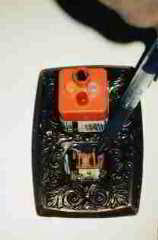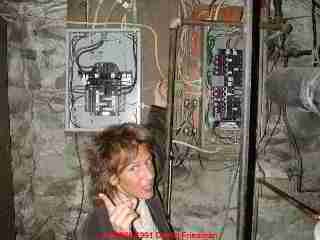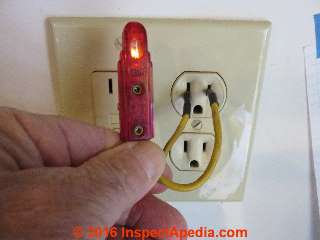how to use voltage tester
 Electrical Tools Every Homeowner Should Have
Electrical Tools Every Homeowner Should Have
- POST a QUESTION or COMMENT about basic electrical test tools used on building electrical wiring
InspectAPedia tolerates no conflicts of interest. We have no relationship with advertisers, products, or services discussed at this website.
Basic electrical test tools every inspector or home owner should have, and how to use them:
This article answers basic questions electrical repair tools and a simple voltage presence or absence test for homeowners looking at an electrical outlet.
This website provides information about a variety of electrical hazards in buildings, with articles focused on the inspection, detection, and reporting of electrical hazards and on proper electrical repair methods for unsafe electrical conditions.
We also provide an ARTICLE INDEX for this topic, or you can try the page top or bottom SEARCH BOX as a quick way to find information you need.
Basic Electrical Tools & Instruments for Working With Electricity

Watch Out:
Do not attempt to work on your electrical wiring, switches, or outlets unless you are properly trained and equipped to do so. Electrical components in a building can easily cause an electrical shock, burn, or even death.
Even when a hot line switch is off, one terminal on the switch is still connected to the power source. Before doing any work on the switch, the power source must be turned off by setting a circuit breaker to OFF or removing a fuse
. See SAFETY for ELECTRICAL INSPECTORS
and ELECTRICAL WIRING BOOKS & GUIDES
Elizabeth Sluder and Daniel Friedman + technical reviewers
With a few exceptions, you probably have the tools you need for most electrical repairs. All you need are common hand tools, some power tools, electrical supplies, and a few special items.
Three Simple Electrical Test Tools that Every Homeowner Should Have & Use
Voltage tester or "Neon Tester"
 A simple low-cost electrical voltage tester is used to determine if an electrical wire or component has been turned off, or if electrical power is present.
A simple low-cost electrical voltage tester is used to determine if an electrical wire or component has been turned off, or if electrical power is present.
A voltage tester, also called a "neon tester" consists of a holder containing a neon bulb.
Two probes are attached to the holder. The neon bulb will light when the probes touch the hot and neutral power lines or anything connected to those lines when power is present on the wires. We discuss use of this tool in more detail
at VOLTS / AMPS MEASUREMENT EQUIP.
For basic homeowner electrical repair procedures, the voltage tester is primarily used to make certain NO voltage is present before you touch any wiring or device. When no voltage is present the bulb does not light. Since the bulb will also not light if the tester is defective in any way, it is especially important that you test the tester from time-to-time.
Simply place the test probes in a live receptacle. If the bulb lights the tester is OK. Make sure the tester you buy can be used on both 120 and 240 volt lines.
Watch out: this is not a reliable nor a complete electrical system test. For example, a weakly-grounded wire or electrode may look just fine when tested with a VOM, a DMM, or a neon tester, but when subject to higher current flow the ground may be completely inadequate.

Above I'm demonstrating use of a neon tester at an indoor electrical receptacle. A detailed example of safe use of a neon tester to check for voltage is at REPAIR AUTOMATIC OUTDOOR LIGHT FIXTURE.
Electrical receptacle tester and GFCI tester (outlet tester).
 If there is a second electrical test tool any homeowner should buy, maybe even the first one, it's a simple outlet wiring tester such as the little tool we show here. If you move into a new home we recommend buying one of these and simply checking out all of your electrical outlets and GFCI's. We're often amazed at how many devices are not wired correctly.
If there is a second electrical test tool any homeowner should buy, maybe even the first one, it's a simple outlet wiring tester such as the little tool we show here. If you move into a new home we recommend buying one of these and simply checking out all of your electrical outlets and GFCI's. We're often amazed at how many devices are not wired correctly.
Simply plugging the receptacle tester into a grounded electrical receptacle will tell you a lot about some common improper and unsafe electrical wiring problems:
- Is the electrical outlet "live" - does it have electricity?
- Is the electrical outlet wired correctly?
- Are the "hot" and "neutral" wires reversed?
- Is the electrical outlet's ground properly connected? (WHY GROUNDING is NEEDED)
Watch Out: People think these receptacle testers, testers, particularly the plug-in 3 lite testers shown here, give a reliable indication. In fact just using a receptacle tester such as this, you can not tell for sure if the ground is adequate. For that matter, one can't tell for sure if the power or neutral have functional connections either, but that is seen by plugging something in Three lite testers don't show some more uncommon flaws either.
They can reliably indicate if there are certain electrical problems (but may not indicate the correct problem or may miss other electrical difficulties in the circuit).
In sum, if your plug-in receptacle tester indicates that there is a problem, there is one. But if the tester does not indicate any problem, there still could be something improper in the circuit.
GFCI Receptacle Test Procedure:
- Correct GFCI wiring: you plug this receptacle tester into a ground fault circuit interrupter GFCI outlet (which you should have or want in lots of locations in your home such as baths, kitchen, garage, basement, outdoors), just by plugging it in the device tests to see not only if the GFCI is wired properly but
- Nuisance tripping: also if the GFCI is going to trip unnecessarily - nuisance tripping.
- Ground fault detection: Then if you push the black test button the tester will put a 14 mA current leak on to the GFCI to see that the GFCI will trip if a ground fault occurs. That is, the test checks to see if the GFCI is doing its job. (You can perform the first group of tests above but you cannot check for ground nor test a GFCI with this device if the GFCI outlet is connected to a two-wire circuit that lacks a ground path.
As a bonus in our photograph above, our plastic, non-conductive pen is pointing out a dangerous condition: the plastic front of the lower half of this electrical receptacle has broken away - someone could be badly shocked or burned. The outlet needs to be replaced immediately.
 Use electrical test instruments to check for live voltage. Test instruments such as the VOM and the TIFTM Tic Tracer described
Use electrical test instruments to check for live voltage. Test instruments such as the VOM and the TIFTM Tic Tracer described
at TOUCHING ELECTRICAL EQUIPMENT, and the contact and "touchless" pens (photo at left) are tools used to detect the presence of voltage are inexpensive, effective, safer when used properly.
See VOLTS / AMPS MEASUREMENT EQUIP for a description of tools used to detect the presence of live electrical wires & devices and for the measurement of actual volts or amps.
None of these neat little electrical test tools (neon tester, receptacle tester, voltage pen) can be relied on to report low levels of current leakage.
At an investigation of a garage roof that shocked a crew of builders during reconstruction after a lightning strike, we measured voltage varying between about 38 volts AC and 68 volts AC between some framing components and the earth.
Watch Out : We could not detect these conditions with a neon tester. A VOM or DMM was needed. Details on safe use of DMM's and VOMs are at DMMs VOMs SAFE USE OF.
Basic Hand Tools Needed for Simple Electrical Repairs
- Long-nose pliers
- Linemen's pliers
- Screwdriver set (small and medium sizes will do the job)
- Phillips-head screwdriver set (needed for appliance work)
- Folding rule or steel tape Utility knife or pocketknife
- Hammer
- Keyhole saw
- Hacksaw
- Flashlight
Simple Supplies for Basic Electrical Repairs
- Plastic electrical tape
- Cable staples
Additional Supplies for Needed Basic Electrical Appliance Repairs (such as a clock radio)
- Solderless connectors (get a variety of sizes and types) and a crimping tool to bind these connectors to electrical wires.
If your repair work involves wire splicing in an appliance like a clock radio, it is desirable to solder the splice to assure good electrical contact. A high heat electric iron, or gun, or a pencil flame propane torch, will heat the joint faster and assure a good flow of solder.
- Rosin-core solder (marked as suitable for electrical work)
- Non corrosive flux
- Soldering gun
Descriptions of some Special Electrical Tools & Test Instruments
Continuity tester
A basic electrical continuity tester is used to find out if a wire is continuous or if it has been broken (or disconnected). A continuity tester is a pen-like probe with an alligator clip lead attached or with two probe-ended leads if you're using a VOM as a continuity tester. The probe contains a battery and bulb. When current flows from the alligator clip to the tip of the probe, the bulb lights. Lots of ohm-meters provide a continuity test function by emitting a tone if the meter finds a sound electrical connection between two points.
SAFETY WARNING: An electrical continuity tester is always used with power off. The low battery voltage can be used to check switches, lamps, fuses and wiring.
 An electrical continuity tester is a good tool to use to check your wiring work before applying power for the first time.
An electrical continuity tester is a good tool to use to check your wiring work before applying power for the first time.
The continuity tester is easily checked before use by touching the alligator clip to the tip of the probe. If the light goes on, the battery is OK and the tester is ready for use.
A digital multimeter such as the tiny one shown in our photo combines several electrical test functions and can be used to check for the presence of live electrical power, to check the voltage level, and in another switch position, it can serve as a continuity tester.
See VOLTS / AMPS MEASUREMENT EQUIP for details about using this and related electrical tools.
Electrical Wire Stripping Tools
Many types of tools are available for stripping insulation from wire. All consist of a pliers-like tool with cutouts on the jaws corresponding to various wire sizes. The cutouts allow the stripper to cut through the insulation without cutting or nicking the conductor Some strippers also have provision for cutting wires and small bolts.
Fish Tape for Pulling Electrical Wires
A "fish tape" is is a flexible wire used to pull electrical cables through building walls and ceilings, also referred to as "fishing wires". We need a fish tape (or a substitute) when we need to pull a wire through existing walls, floors, or ceilings where finished surfaces have been installed.
Fish tapes for pulling electrical wires are available in various lengths. The fish tape has a hook at the end to which the wire can be attached after the tape is worked through the opening. The tape is then withdrawn pulling the wire through.
Electrical Fuse Puller
If there are cartridge fuses on your service panel, you will need a fuse puller for safe removal of fuses. Check the sizes of the fuses you will have to remove before you purchase a fuse puller. Make certain the puller you buy is the right size for your use.
Simple but Useful Electrical Tests of an Electrical Outlet With a Neon Tester or Voltage Tester
Two simple and inexpensive testers are absolutely essential to electrical work. If you own a handitester or similar volt-ohm meter, that will do the same job.
How to Test For Correct Ground Connections & for Presence of Electrical Power with a Voltage Tester
Watch Out:
Do not attempt to work on your electrical wiring, switches, or outlets unless you are properly trained and equipped to do so. Electrical components in a building can easily cause an electrical shock, burn, or even death.
Watch Out : Even when a hot line switch is off, one terminal on the switch is still connected to the power source. Before doing any work on the switch, the power source must be turned off by setting a circuit breaker to OFF or removing a fuse.
See SAFETY for ELECTRICAL INSPECTORS
and ELECTRICAL WIRING BOOKS & GUIDES
3-slot Electrical Receptacle Test Procedure
Touch one voltage tester probe inside the ground slot and the other probe to each of the prong slots in turn. The bulb should light in one of them. The slot in which the bulb lights will tell you which is the "hot" connection; the other slot in the receptacle will be the neutral connection.
You can also determine whether or not the receptacle has been properly wired by this method (the larger slot should be the neutral wire) but a simpler plug-in electrical receptacle tester does the job more easily and more safely.
See VOLTS / AMPS MEASUREMENT EQUIP for details about using this and related electrical tools.
2-slot Electrical Receptacle Test Procedure
Touch one probe to the screw on the outside of the cover plate and the other probe in each slot in turn. The bulb should light in one of them - maybe.
If the receptacle cover plate screw is metal it is touching a metal strap that holds the plastic body parts of the electrical receptacle together. That same metal strap ends in "ears" that include holes through which the electrical receptacle is mounted to the electrical junction box in the building wall
If the electrical junction box is metal and if the electrical junction box is itself connected to the building grounding system, that strap, by touching the metal junction box, provides an unreliable ground path which will let you per from the test above.
The proper method of making the ground connection for an electrical receptacle is through a ground wire connecting the ground screw on the electrical receptacle body to the ground wire entering the electrical junction box - if there is a ground wire.
If the 2-slot electrical receptacle is installed on an electrical circuit which does not include a ground path (such as knob and tube electrical wiring) or if the 2-slot receptacle has not been properly mounted and grounded, this test may not show you anything, but the receptacle may still be "live" - a condition that shows up the two voltage tester probes are inserted one-each into the two receptacle slots.
If you find that the receptacle is live but that connecting the receptacle cover plate through the voltage tester to each receptacle slot in turn does not cause the tester to show power, then that electrical circuit may not be safely grounded, and further investigation by a professional is warranted.
Watch Out : this is not a reliable nor a complete test. For example, a weakly-grounded wire or electrode may look just fine when tested with a VOM, a DMM, or a neon tester, but when subject to higher current flow the ground may be completely inadequate.
...
Continue reading at SAFETY for ELECTRICAL INSPECTORS or select a topic from the closely-related articles below, or see the complete ARTICLE INDEX.
Or see DMMs VOMs SAFE USE OF
Suggested citation for this web page
ELECTRICAL TOOLS BASIC at InspectApedia.com - online encyclopedia of building & environmental inspection, testing, diagnosis, repair, & problem prevention advice.
Or see this
INDEX to RELATED ARTICLES: ARTICLE INDEX to ELECTRICAL INSPECTION & TESTING
Or use the SEARCH BOX found below to Ask a Question or Search InspectApedia
how to use voltage tester
Source: https://inspectapedia.com/electric/Electrical_Tools.php
Posted by: peetehiecand.blogspot.com

0 Response to "how to use voltage tester"
Post a Comment